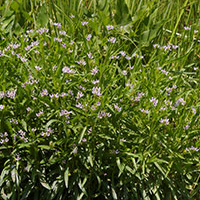American Water-willow
Scientific name: Justicia americana

Photo credit: Rob Tervo
Status
Threatened
“Threatened” means the species lives in the wild in Ontario, is not endangered, but is likely to become endangered if steps are not taken to address factors threatening it.
Date added to the Species at Risk in Ontario List
The American Water-willow was already assessed as at-risk when the Endangered Species Act, 2007 took effect in 2008.
Read the most recent assessment report (PDF).
What it looks like
The American Water-willow is an aquatic plant that grows 20 to 100 centimetres high. It has white or pale violet tube-shaped flowers marked with purple on the lower lip. The narrow leaves are eight to 16 centimetres long. The fruit is a capsule that contains two to four beige or light brown seeds.
The plant usually spreads by rhizomes and is capable of forming large colonies. The flowers bloom in May or early summer, and bees are the main pollinators. The seeds mature from mid-July to the end of the summer when they are ejected from the plant and dispersed by water.
Where it lives
The range of the American Water-willow is limited to east central North America from Georgia and Texas north to New York, Michigan, southern Ontario and Quebec.
The American Water-willow grows along the shores and in the waters of:
- streams
- rivers
- lakes
- ditches
- occasionally wetlands
It can grow on wet soil and in up to 1.2 metres of water but appears to require periodic flooding and wave action to reduce competition from other aquatic plants.
The underlying subsoil on which it grows is usually gravel, sand or organic matter.
Where it’s been found in Ontario
In Ontario, the number of locations where the species could be found ranges from six to 10. The majority of subpopulations in Ontario are along the Lake Erie shoreline. Subpopulations are also found along the Welland River and St. Lawrence River and a subpopulation may occur at Sharbot Lake, although it is unclear whether that subpopulation still exists.
What threatens it
The most significant threat to American Water-willow is habitat loss and degradation resulting from changes in water levels and water quality, potentially caused by dams and residential or industrial development.
Individual plants may be harmed as a result of recreational activities such as boating. In some areas, invasive species such as the European Common Reed (Phragmites australis) may be a threat to American Water-willow.
Action we are taking
This species and its habitat are protected under Ontario’s Endangered Species Act, 2007 (ESA).
The ESA also requires us to prepare recovery guidance for threatened species such as American Water-willow to guide recovery efforts for the species in Ontario.
All species listed on the Species at Risk in Ontario List may be eligible for consideration for government funding through the Species at Risk Stewardship Program.
Recovery strategy
A recovery strategy advises the ministry on ways to ensure healthy numbers of the species return to Ontario.
Read the executive summary (January 11, 2013)
Read the recovery strategy (January 11, 2013)
Government response statement
A government response statement outlines the actions the government intends to take or support to help recover the species.
Read the government response statement (October 11, 2013)
Five-year review of progress
A five-year review of progress made toward protecting and recovering a species is required no later than five years after the government response statement for that species is published.
Read the report on progress towards the protection and recovery of 17 species at risk, including the American Water-willow (2018).
Habitat protection
June 30, 2013
What you can do
Report a sighting
Submit your observations of species at risk to the Natural Heritage Information Centre (NHIC), which is Ontario’s conservation data centre. Join the centre’s Rare Species of Ontario project in iNaturalist, an online plant and animal identification app, to quickly and easily submit your observations.
Volunteer
Volunteer with your local nature club or provincial park to participate in surveys or stewardship work focused on species at risk.
Be a good steward
- Private landowners have a very important role to play in species recovery. If you find species at risk on your land, you may be eligible for stewardship programs that support the protection and recovery of species at risk and their habitats, such as the Species at Risk Stewardship Program.
- Invasive species seriously threaten many of Ontario’s species at risk. To learn what you can do to help reduce the threat of invasive species, visit:
Report illegal activity
Report any illegal activity related to plants and wildlife to
Quick facts
- American Water-willow (Latin name: Justicia americana) is named after James Justice who was an 18th century Scottish horticulturalist and botanist. “Americana” refers to the plant being native to the Americas.
- The American Water-willow is well adapted to growing in areas that are disturbed by water level fluctuations. Because it spreads clonally by a thick underground rhizome, or horizontal stem, it can contribute to the stabilization of the banks of rivers and streams.
- The American Water-willow is at the northern limit of its range in Canada, where it is relatively uncommon. Estimates of numbers of stems in Ontario, based on 2007 and 2008 counts, total approximately 100,000. In Quebec, totals for 2007 are estimated to be about 25.5 million.
- The American Water-willow is the only member of the Acanthus family in Canada, a family consisting mostly of tropical species with centers of diversity in Indonesia, Malaysia, Africa, Brazil and Mesoamerica.